Ingredient Glossary

Welcome to the pet food ingredient glossary!! Here, I’ll list many of the major ingredients you’ll see in pet foods, ranging from the most cheaply made to the finest available. If this doesn’t open your eyes to what’s wrong (and right) in the pet food industry, I’m not sure what will! Here we go….
Animal By-Products:
The word “by-product” is an instant turn off when it comes to pet food. It basically entails anything that humans most certainly would NOT touch, and would not give to their pet. For instance, would you lay down beaks, feet and random organs for your pet to eat?? How about feathers?? Blood?? Well, those are the primary components in anything labelled “by-products”. Sometimes it’ll say “chicken by-products” so at least you can identify the animal. However, sometimes the label says “meat by-products”, which tells you they want to hide exactly what animal they’re using from you. This is because it’s been documented that roadkill and pests like rats are used in some cheap pet foods….
Animal Digest:
The first two ingredients by alphabetical order are two of the worst. “Animal Digest” is a broth that’s cooked up of stuff that we’d rather just not know about. It can include some of what’s in the aforementioned by-products, but also skin and the contents of the animal’s stomach after it was slaughtered. Yuck. It’s the soup that you won’t find Campbell’s offering anytime soon.
Barley:
Barley is a pretty good quality grain in pet foods. It’s not a main source of allergies, and it’s easily digestible. So if grains are in the pet food, as they are in most, this is a welcome sight.
Beef Tallow:
If you’re going to ingest pure fat, what animal would you rather it be from….chicken or cow?? Turkey or cow?? The reason why cheap pet food companies use beef tallow is simple: it’s very cheap. It’s also a very bad fat source for pets as it is for humans. This is pure, greasy, white cow fat. Yummy.
Brewers Rice or Brewers Yeast:
At first, a person may look at the word “brewer” here and be reminded of a person who makes alcohol. Well, there’s a good reason for that, because that’s exactly what these ingredients are. They happen to be the leftovers from the alcohol-making process, which is bought very cheaply by the pet food companies. It’s devoid of nutritional value, being as how it’s been absolutely used up by the time it’s used in the food. It’s just a filler. Despite this, it’s found in one third of pet foods available in the US.
Canola Oil:
A decent fat source, although not the best. It certainly beats beef tallow, but isn’t as good as any sort of fish oil or sunflower oil.
Corn Gluten Meal:
This is the remainder of the corn after the best parts of the corn have been removed. This is why I call it “filler of a filler”. One of the absolute worst ingredients, as it does absolutely nothing for the animal and actually is difficult to digest.
Eggs:
Eggs are one of the best protein sources there are. The best thing to see is “whole eggs”, but even “dried eggs” or “egg product” is going to be a fairly good protein source.
Fish Meal:
This is a non-descriptive source of protein which is low in omega fatty acids as the oil is pressed out. The quality of this ingredient in pet food is suspect, as poor quality and rancid fish are often used. It’s found in approximately 8% of pet foods on the market.
Fish Oil:
This includes salmon oil. Very rich in Omega 3 and Omega 6 fatty acids, which are absolutely excellent for heart health. This is one of the finest, if not the finest, fat source possible in pet foods.
Flaxseed Oil:
Another great fat source, with Omega 3 and Omega 6 fatty acids for heart health. Cheap foods will almost never have this.
Fruits:
Much like humans, animals benefit from fruits as well. They’re excellent sources of fiber and vitamins. Some you’ll see in foods include blueberries, cranberries, and apples. It’s an expensive ingredient, so expect to find this in your finer foods.
Meats (chicken, turkey, duck, etc.):
Any time a meat is named on the label, this is a good thing as long as “by-product” isn’t behind it. However, be advised that if the word “meal” is not behind it, they are weighing it BEFORE it is dehydrated for inclusion in the dry food, which gives sort of a false ranking of what proportion of it is really included in the food. This leads us to the next entry….
Meat “meals” (chicken meal, turkey meal, fish meal, etc):
One of the best ingredients you can see in a pet food, this means that the meat is of a decent quality and it was weighed AFTER it was dehydrated…therefore meaning the proteins are more condensed. Seeing these towards the top of the ingredient list is a great thing.
Meat and Bone Meal:
One of the lowest quality meat products used. The origin of the meat is suspect, as it isn’t named. If the manufacturers wanted you to know what the source was, they’d name it. Since it’s probably not braggable, it’s just put down as “meat”. Not only that, but the lowest-quality parts of the animal are generally used as well. Oh, and as the name suggest….ground bone as well. Nothing good about this one.
Natural Flavors:
There are varying reports about this. The more expensive companies state they are just using broth created when the animals are being cooked, but I’ve read about there being not-so-flattering methods of getting these flavors with bargain manufacturers.
Oatmeal:
This is another pretty good grain, much like barley and rice. It’s generally found in more expensive food but not exclusively.
Peas
Peas and pea starch are a good source of carbs, with the latter containing omega-3 fatty acids. They’re also a good addition to any pet food if you cook them to a pulp so they’re easier to digest, so there’s a little tip.
Pea fibre has been seen in recent years as a replacement for corn, wheat, beet pulp, and soybeans. It is regarded as a largely insoluble fibre, but this is questionable.
Potatoes (or sweet potatoes):
This is the single best carb source in pet foods, and is a good ingredient to see.
Rice (or whole grain rice):
This is generally thought of as being the best grain that can be put into pet food. Rice “bran” or “flour” is NOT the same, however, as nutritional quality is diminished with those processes are used on the rice. This is easily digestible, and a good source of fiber for animals.
Salt:
Run, don’t walk, if this is included highly in a pet food. Excess salt isn’t good for humans, and it isn’t good for pets either. If this is included in a pet food, chances are it’s missing something else.
Soybeans:
A rather low-quality grain, and source of food allergies. It’s a cheap ingredient typically used by cheap companies with little benefit to the animals.
Sugar (or corn syrup):
Bad ingredient used by companies to make food more palatable to the animals if the ingredients themselves aren’t enough to make the dog or cat actually want to eat it.
Wheat:
Absolutely useless ingredient in pet food and a leading cause of food allergies in dogs. “Wheat middlings” are especially bad, since they are considered to be the “sweepings” off the floor. Absolutely AVOID this if at all possible.


